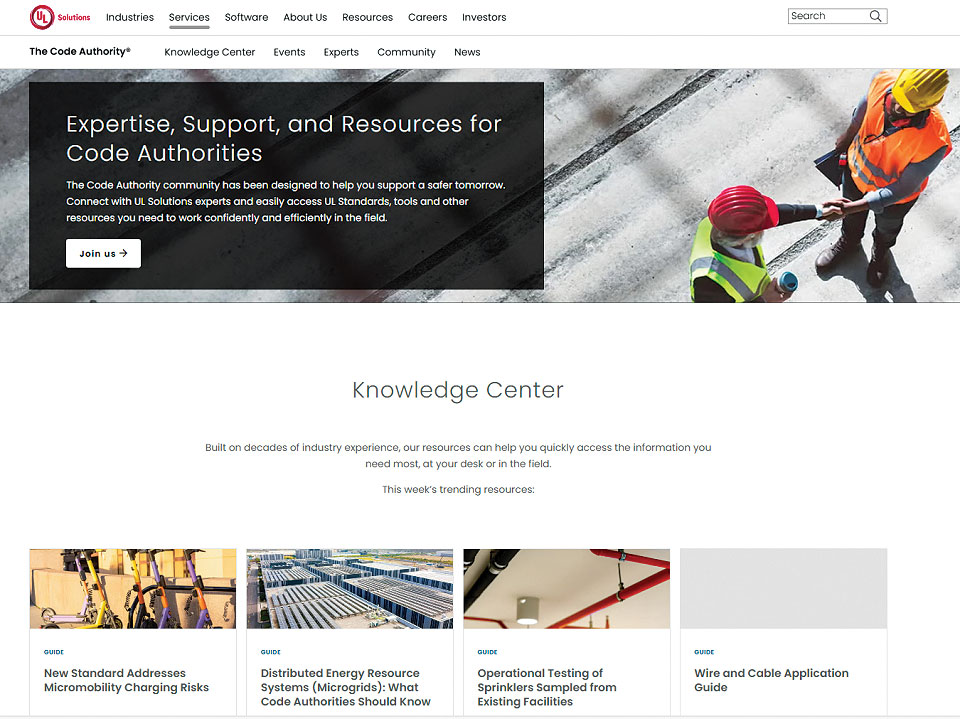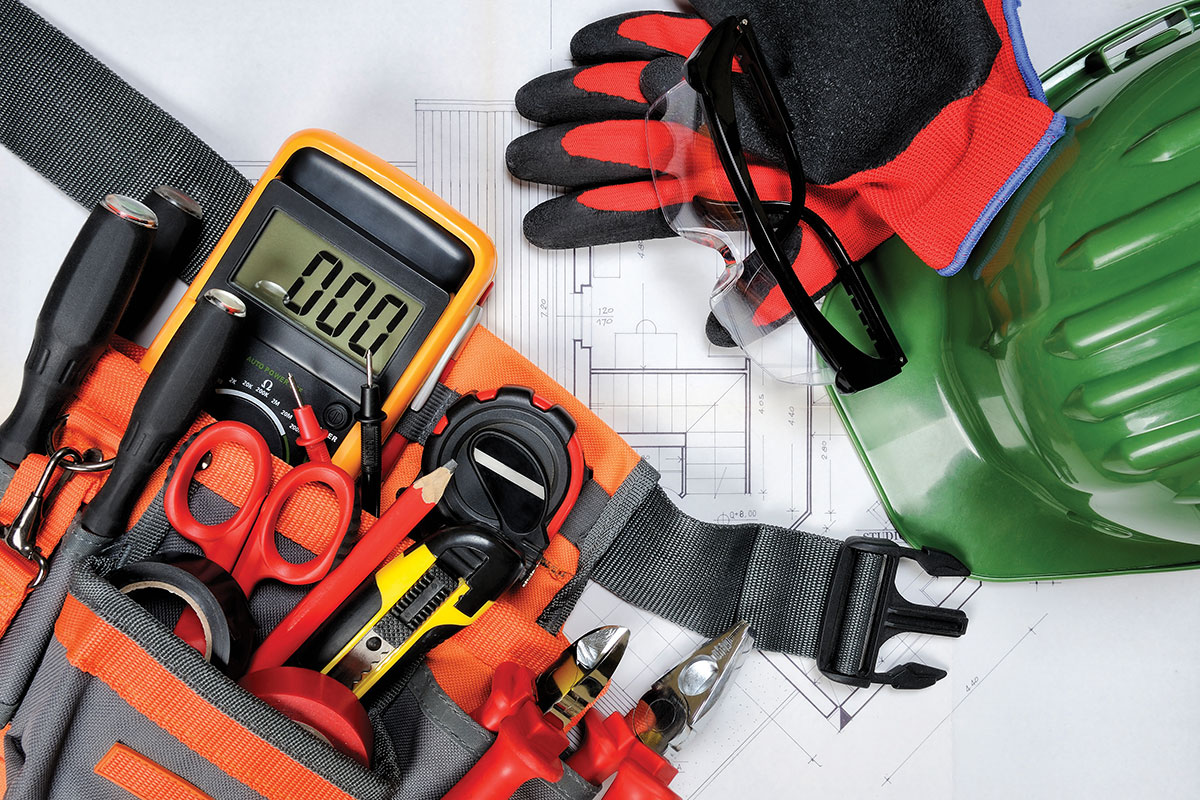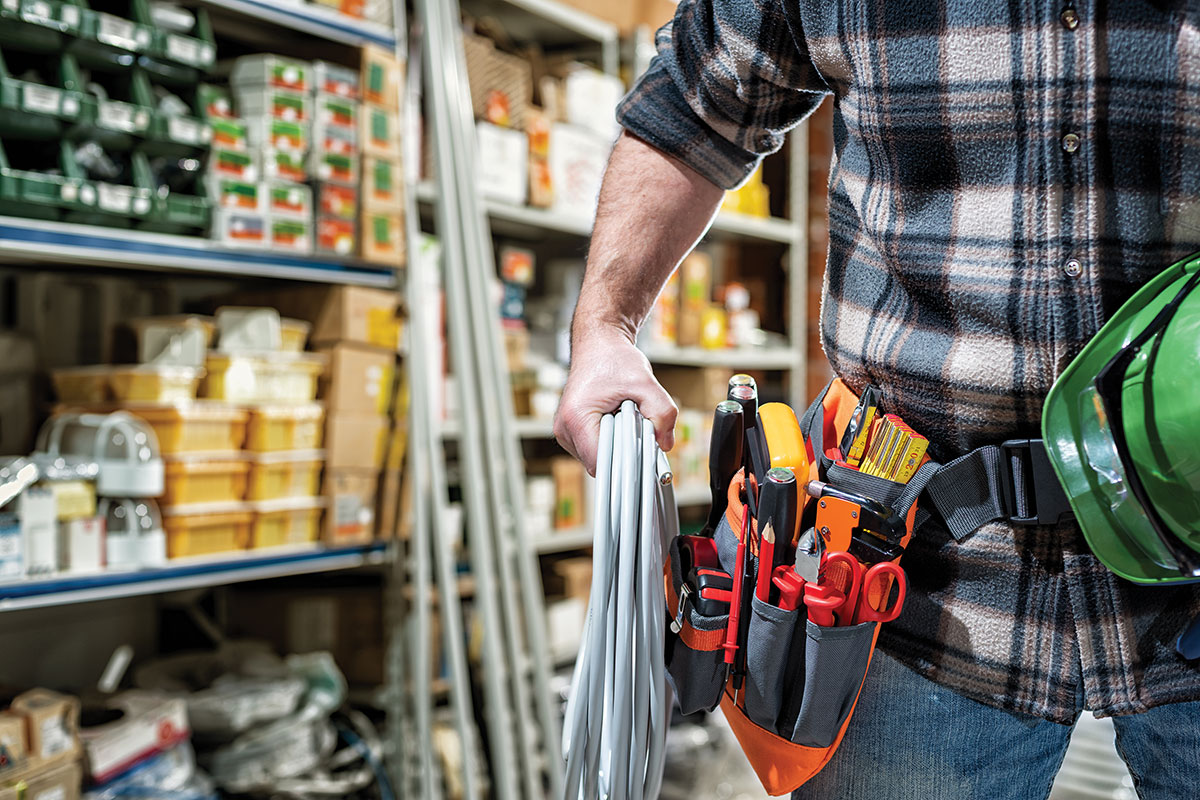Tools are such a common part of our lives that it is difficult to remember that they may pose hazards. Tragically, a serious incident can occur before steps are taken to identify and avoid or eliminate tool-related hazards.
Employees who use hand and power tools and are exposed to the hazards of falling, flying, abrasive, and splashing objects, or to harmful dust, fumes, mists, vapors, or gases must be provided with the appropriate personal protective equipment. All electrical connections for these tools must be suitable for the type of tool and the working conditions (wet, dusty, flammable vapors). When a temporary power source is used for construction, a ground-fault circuit interrupter should be used. This article is designed to present to employees and employers a summary of the basic safety procedures and safeguards associated with hand and portable power tools.
Employees should be trained in the proper use of all tools. Workers should be able to recognize the hazards associated with the different types of tools and the safety precautions necessary.
Five basic safety rules can help prevent hazards associated with the use of hand and power tools:
- Keep all tools in good condition with regular maintenance.
- Use the right tool for the job.
- Examine each tool for damage before use, and do not use damaged tools.
- Operate tools according to the manufacturer’s instructions.
- Provide and use properly the right personal protective equipment.
Employees and employers should work together to establish safe working procedures. If a hazardous situation is encountered, it should be brought immediately to the attention of the proper individual for hazard abatement.
The following sections identify various types of hand and power tools and their potential hazards. They also identify ways to prevent worker injury through the proper use of the tools and through the use of appropriate personal protective equipment.
What Are the Hazards of Hand Tools?
Hand tools are tools that are powered manually. Hand tools include anything from axes to wrenches. The greatest hazards posed by hand tools result from misuse and improper maintenance.
Some examples include the following:
- If a chisel is used as a screwdriver, the tip of the chisel may break and fly off, hitting the user or other employees.
- If a wooden handle on a tool, such as a hammer or an axe, is loose, splintered, or cracked, the head of the tool may fly off and strike the user or other employees.
- If the jaws of a wrench are sprung, the wrench might slip.
- If impact tools such as chisels, wedges, or drift pins have mushroomed heads, the heads might shatter on impact, sending sharp fragments flying toward the user or other employees.
The employer is responsible for the safe condition of tools and equipment used by employees. Employers shall not issue or permit the use of unsafe hand tools. Employees should be trained in the proper use and handling of tools and equipment.
Employees, when using saw blades, knives, or other tools, should direct the tools away from aisle areas and away from other employees working in close proximity. Knives and scissors must be sharp; dull tools can cause more hazards than sharp ones. Cracked saw blades must be removed from service.
Wrenches must not be used when jaws are sprung to the point that slippage occurs. Impact tools such as drift pins, wedges, and chisels must be kept free of mushroomed heads. The wooden handles of tools must not be splintered.
Iron or steel hand tools may produce sparks that can be an ignition source around flammable substances. Where this hazard exists, spark-resistant tools made of non-ferrous materials should be used where flammable gases, highly volatile liquids, and other explosive substances are stored or used.
What Are the Dangers of Power Tools?
Appropriate personal protective equipment, such as safety goggles and gloves, must be worn to protect against hazards that may be encountered while using hand tools.
Workplace floors shall be kept as clean and dry as possible to prevent accidental slips with or around dangerous hand tools.
Power tools must be fitted with guards and safety switches; they are extremely hazardous when used improperly. The types of power tools are determined by their power source: electric, pneumatic, liquid fuel, hydraulic, and powder-actuated.
To prevent hazards associated with the use of power tools, workers should observe the following general precautions:
- Never carry a tool by the cord or hose.
- Never yank the cord or the hose to disconnect it from the receptacle.
- Keep cords and hoses away from heat, oil, and sharp edges.
- Disconnect tools when not using them, before servicing and cleaning them, and when changing accessories such as blades, bits, and cutters.
- Keep all people not involved with the work at a safe distance from the work area.
- Secure work with clamps or a vise, freeing both hands to operate the tool.
- Avoid accidental starting. Do not hold fingers on the switch button while carrying a plugged-in tool.
- Maintain tools with care; keep them sharp and clean for best performance.
- Follow instructions in the user’s manual for lubricating and changing accessories.
- Be sure to keep good footing and maintain good balance when operating power tools.
- Wear proper apparel for the task. Loose clothing, ties, or jewelry can become caught in moving parts.
- Remove all damaged portable electric tools from use and tag them: “Do Not Use.”
Guards
The exposed moving parts of power tools need to be safeguarded. Belts, gears, shafts, pulleys, sprockets, spindles, drums, flywheels, chains, or other reciprocating, rotating, or moving parts of equipment must be guarded.
Machine guards, as appropriate, must be provided to protect the operator and others from the following:
- Point of operation.
- In-running nip points.
- Rotating parts.
- Flying chips and sparks.
Safety guards must never be removed when a tool is being used. Portable circular saws having a blade greater than 2 inches (5.08 centimeters) in diameter must be equipped at all times with guards. An upper guard must cover the entire blade of the saw. A retractable lower guard must cover the teeth of the saw, except where it makes contact with the work material. The lower guard must automatically return to the covering position when the tool is withdrawn from the work material.
Operating Controls and Switches
The following hand-held power tools must be equipped with a constant-pressure switch or control that shuts off the power when pressure is released: drills; tappers; fastener drivers; horizontal, vertical, and angle grinders with wheels more than 2 inches (5.08 centimeters) in diameter; disc sanders with discs greater than inches (5.08 centimeters); belt sanders; reciprocating saws; saber saws, scroll saws, and jigsaws with blade shanks greater than 1/4-inch (0.63 centimeters) wide, and other similar tools. These tools also may be equipped with a “lock-on” control if it allows the worker to also shut off the control in a single motion using the same finger or fingers. The following hand-held power tools must be equipped with either a positive “on-off” control switch, a constant pressure switch, or a “lock-on” control: disc sanders with discs 2 inches (5.08 centimeters) or less in diameter; grinders with wheels 2 inches (5.08 centimeters) or less in diameter; platen sanders, routers, planers, laminate trimmers, nibblers, shears, and scroll saws; and jigsaws, saber and scroll saws with blade shanks a nominal 1/4-inch (6.35 millimeters) or less in diameter. It is recommended that the constant-pressure control switch be regarded as the preferred device.
Other hand-held power tools, such as circular saws having a blade diameter greater than 2 inches (5.08 centimeters), chain saws, and percussion tools with no means of holding accessories securely, must be equipped with a constant-pressure switch.
Electric Tools
Employees using electric tools must be aware of several dangers. Among the most serious hazards are electrical burns and shocks.
Electrical shocks, which can lead to injuries such as heart failure and burns, are among the major hazards associated with electric-powered tools. Under certain conditions, even a small amount of electric current can result in fibrillation of the heart and death. An electric shock can also cause the user to fall off a ladder or other elevated work surface and be injured due to the fall.
To protect the user from shock and burns, electric tools must have a three-wire cord with a ground and be plugged into a grounded receptacle, be double insulated, or be powered by a low-voltage isolation transformer. Three-wire cords contain two current-carrying conductors and a grounding conductor. Any time an adapter is used to accommodate a two-hole receptacle, the adapter wire must be attached to a known ground. The third prong must never be removed from the plug.
Double-insulated tools are available that provide protection against electrical shock without third-wire grounding. On double-insulated tools, an internal layer of protective insulation completely isolates the external housing of the tool.
The following general practices should be followed when using electric tools:
- Operate electric tools within their design limitations.
- Use gloves and appropriate safety footwear when using electric tools.
- Store electric tools in a dry place when not in use.
- Do not use electric tools in damp or wet locations unless they are approved for that purpose.
- Keep work areas well-lighted when operating electric tools.
- Ensure that cords from electric tools do not present a tripping hazard.
In the construction industry, employees who use electric tools must be protected by ground-fault circuit interrupters or an assured equipment-grounding conductor program.
Pneumatic Tools
Pneumatic tools are powered by compressed air and include chippers, drills, hammers, and sanders.
There are several dangers associated with the use of pneumatic tools. First and foremost is the danger of getting hit by one of the tool’s attachments or by some kind of fastener the worker is using with the tool.
Pneumatic tools must be checked to see that the tools are fastened securely to the air hose to prevent them from becoming disconnected. A short wire or positive locking device attaching the air hose to the tool must also be used and will serve as an added safeguard.
If an air hose is more than ½-inch (12.7 millimeters) in diameter, a safety excess flow valve must be installed at the source of the air supply to reduce pressure in case of hose failure.
In general, the same precautions should be taken with an air hose that are recommended for electric cords because the hose is subject to the same kind of damage or accidental striking and because it also presents tripping hazards.
When using pneumatic tools, a safety clip or retainer must be installed to prevent attachments such as chisels on a chipping hammer from being ejected during tool operation.
Pneumatic tools that shoot nails, rivets, staples, or similar fasteners and operate at pressures more than 100 pounds per square inch must be equipped with a special device to keep fasteners from being ejected unless the muzzle is pressed against the work surface.
Airless spray guns that atomize paints and fluids at pressures of 1,000 pounds or more per square inch (6,890 kPa) must be equipped with automatic or visible manual safety devices that will prevent pulling the trigger until the safety device is manually released.
- Eye protection is required, and head and face protection is recommended for employees working with pneumatic tools.
- Screens must also be set up to protect nearby workers from being struck by flying fragments around chippers, riveting guns, staplers, or air drills.
- Compressed air guns should never be pointed toward anyone. Workers should never “dead-end” them against themselves or anyone else. A chip guard must be used when compressed air is used for cleaning.
- Use of heavy jackhammers can cause fatigue and strains. Heavy rubber grips reduce these effects by providing a secure handhold. Workers operating a jackhammer must wear safety glasses and safety shoes that protect them against injury if the jackhammer slips or falls. A face shield also should be used.
Noise is another hazard associated with pneumatic tools. Working with noisy tools such as jackhammers requires proper, effective use of appropriate hearing protection.
Powder-Actuated Tools
Powder-actuated tools operate like a loaded gun and must be treated with extreme caution. In fact, they are so dangerous that they must be operated only by specially trained employees.
When using powder-actuated tools, an employee must wear suitable ear, eye, and face protection. The user must select a powder level—high or low velocity—that is appropriate for the powder-actuated tool and necessary to do the work without excessive force.
The muzzle end of the tool must have a protective shield or guard centered perpendicular to and concentric with the barrel to confine any fragments or particles that are projected when the tool is fired. A tool containing a high-velocity load must be designed not to fire unless it has this kind of safety device.
To prevent the tool from firing accidentally, two separate motions are required for firing. The first motion is to bring the tool into the firing position, and the second motion is to pull the trigger. The tool must not be able to operate until it is pressed against the work surface with a force of at least 5 pounds (2.2 kg) greater than the total weight of the tool.
If a powder-actuated tool misfires, the user must hold the tool in the operating position for at least 30 seconds before trying to fire it again. If it still will not fire, the user must hold the tool in the operating position for another 30 seconds and then carefully remove the load in accordance with the manufacturer’s instructions. This procedure will make the faulty cartridge less likely to explode. The bad cartridge should then be put in water immediately after removal. If the tool develops a defect during use, it should be tagged and must be taken out of service immediately until it is properly repaired.
Safety precautions that must be followed when using powder-actuated tools include the following:
- Do not use a tool in an explosive or flammable atmosphere.
- Inspect the tool before using it to determine that it is clean, that all moving parts operate freely, and that the barrel is free from obstructions and has the proper shield, guard, and attachments recommended by the manufacturer.
- Do not load the tool unless it is to be used immediately.
- Do not leave a loaded tool unattended, especially where it would be available to unauthorized persons.
- Keep hands clear of the barrel end.
- Never point the tool at anyone.
When using powder-actuated tools to apply fasteners, several additional procedures must be followed:
- Do not fire fasteners into material that would allow the fasteners to pass through to the other side.
- Do not drive fasteners into very hard or brittle material that might chip or splatter or make the fasteners ricochet.
- Always use an alignment guide when shooting fasteners into existing holes.
- When using a high-velocity tool, do not drive fasteners more than 3 inches (7.62 centimeters) from an unsupported edge or corner of material such as brick or concrete.
- When using a high-velocity tool, do not place fasteners in steel any closer than 1/2-inch (1.27 centimeters) from an unsupported corner edge unless a special guard, fixture, or jig is used.
Hydraulic Power Tools
The fluid used in hydraulic power tools must be an approved fire-resistant fluid and must retain its operating characteristics at the most extreme temperatures to which it will be exposed. The exception to fire-resistant fluid involves all hydraulic fluids used for the insulated sections of derrick trucks, aerial lifts, and hydraulic tools that are used on or around energized lines. This hydraulic fluid shall be of the insulating type.
The manufacturer’s recommended safe operating pressure for hoses, valves, pipes, filters, and other fittings must not be exceeded.
All jacks—including lever and ratchet jacks, screw jacks, and hydraulic jacks—must have a stop indicator, and the stop limit must not be exceeded. Also, the manufacturer’s load limit must be permanently marked in a prominent place on the jack, and the load limit must not be exceeded.
A jack should never be used to support a lifted load. Once the load has been lifted, it must immediately be blocked up. Put a block under the base of the jack when the foundation is not firm, and place a block between the jack cap and load if the cap might slip.
To set up a jack, make certain of the following:
- The base of the jack rests on a firm, level surface;
- The jack is correctly centered;
- The jack head bears against a level surface; and
- The lift force is applied evenly.
Proper maintenance of jacks is essential for safety. All jacks must be lubricated regularly. In addition, each jack must be inspected according to the following schedule: (1) for jacks used continuously or intermittently at one site—inspected at least once every 6 months, (2) for jacks sent out of the shop for special work—inspected when sent out and inspected when returned, and (3) for jacks subjected to abnormal loads or shock—inspected before use and immediately thereafter.
What Help Can OSHA Provide?
OSHA can provide extensive help through a variety of programs, including assistance about safety and health programs, state plans, workplace consultations, voluntary protection programs, strategic partnerships, training and education, and more.
Safety and Health Program Management Guidelines
Working in a safe and healthful environment can stimulate innovation and creativity and result in increased performance and higher productivity.
To assist employers and employees in developing effective safety and health management systems, OSHA published recommended Safety and Health Program Management Guidelines (Federal Register 54(16): 3904-3916, January 26, 1989). These voluntary guidelines can be applied to all places of employment covered by OSHA.
The guidelines identify four general elements that are critical to the development of a successful safety and health management system. These are the following:
- Management leadership and employee involvement,
- Worksite analysis,
- Hazard prevention and control, and
- Safety and health training.
The guidelines recommend specific actions under each of these general elements to achieve an effective safety and health management system. The Federal Register notice is available online at www.osha.gov.















Find Us on Socials